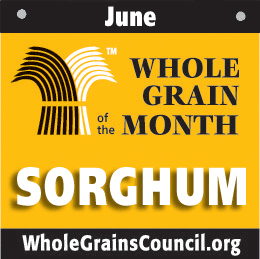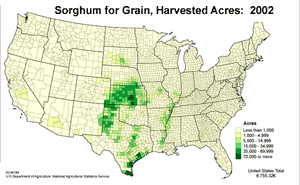


June’s Grain of the Month is Sorghum. Ask a hundred people if they’ve ever eaten sorghum and chances are, they’ll have no idea what you’re talking about. However, sorghum, a cereal grain, is the fifth most important cereal crop in the world, largely because of its natural drought tolerance and versatility as food, feed and fuel. In Africa and parts of Asia, sorghum is primarily a human food product, while in the United States it is used mainly for livestock feed and in a growing number of ethanol plants. However, the United States also has seen food usage on the rise, thanks to the gluten-free benefits of sorghum for those with celiac disease.
OUT OF AFRICA
Sorghum [Sorghum bicolor (L.) Moench] is known under a great many names: milo, guinea corn in West Africa, kafir corn in South Africa, dura in Sudan, mtama in eastern Africa, jowar in India and kaoliang in China.
Sorghum is an ancient cereal grain and was collected 8000 years ago in Southern Egypt, in a place called Nabta Playa. Sorghum was domesticated in Ethiopia and Sudan and from there moved throughout all of Africa, where it remains an important cereal grain. (That’s a picture of sorghum being grown in an Ethiopian field.)
Sorghum likely traveled to India during the first millennium BC, taken as food on ships, and then continued to be disbursed along the silk trade routes. It most probably arrived in the Americas with slave traders from Africa in the 19th century.
Today different varieties of sorghum are grown in Asia, including India and Micronesia, and in both North America and Latin America. Sorghum kernels vary in color from white and pale yellow to deep reds, purples and browns; white, bronze, and brown kernels are most common.
Click here to see more sorghum photos
SO GOOD FOR YOU
Increased prevalence and diagnosis of celiac disease have led to strong growth in the gluten-free market, of which sorghum is a key component. While 40,000 to 60,000 Americans have been diagnosed as celiac, the federal government estimates there could be as many as 3 million undiagnosed. A gluten-free diet incorporating sorghum also has been adopted by many with autism, ADHD and irritable bowel syndrome, although research in this area is limited.
But being gluten-free isn’t sorghum’s only bragging right. It’s also a whole grain that provides many other nutritional benefits. Sorghum, which doesn’t have an inedible hull like some other grains, is commonly eaten with all its outer layers, thereby retaining the majority of its nutrients. Sorghum also is grown from traditional hybrid seeds and does not contain traits gained through biotechnology, making it nontransgenic (non-GMO).
Some specialty sorghums are high in antioxidants, which are believed to help lower the risk of cancer, diabetes, heart disease and some neurological diseases. In addition, the wax surrounding the sorghum grain contains compounds called policosanols, that may have an impact on human cardiac health. Some researchers, in fact, believe that policosanols have cholesterol-lowering potency comparable to that of statins.
Click here to see research studies on sorghum and health.
SO EASY TO USE
Sorghum can be substituted for wheat flour in a variety of baked goods. Its neutral, sometimes sweet, flavor and light color make it easily adaptable to a variety of dishes. Sorghum improves the texture of recipes and digests more slowly with a lower glycemic index, so it sticks with you a bit longer than other flours or flour substitutes.
A wide variety of recipes using sorghum can be found online and in cookbooks, particularly those catering to a gluten-free diet. These recipes include muffins, breads, pizzas, pastas, casseroles, cookies, cakes, pies and more.To get you started, here are links to some sorghum recipes here on the Whole Grains Council website:
Molasses Sorghum Cookies
Sorghum Egg Noodles
Gluten-Free Apple Crisp
Sorghum Pie Crust
Milo Salad with Oregano, Feta and Cucumbers
Sorghum Pancakes
Gluten-Free Chocolate Chip Cookies
Sorghum Bread
You can also substitute sorghum in your existing recipes. Start with recipes that use relatively small amounts of wheat flour, such as brownies or pancakes. Substituting sorghum takes some experimenting and patience, but the results can be very delicious. Because sorghum flour does not contain gluten, bakers often incorporate a binder such as xanthan gum or cornstarch to add “stretch.” For instance, you could add 1/2 teaspoon xanthan gum per cup of sorghum flour for cookies and cakes, and 1 teaspoon per cup for breads.
While it’s easy to make familiar Western dishes with sorghum, like those above, it’s also interesting to know how sorghum fts into food traditions in other parts of the world. In the Mideast, sorghum is made into cous-cous and flatbread; in Bangladesh it’s boiled like rice, to produce kichuri; and in Honduras, sorghum tortillas are common.
Throughout Africa, you’ll find sorghum porridge or gruel in almost every country, and sorghum flatbreads such as injera , the Ethiopian flatbread (which is made from sorghum or teff or a combination of both). Both alcoholic and non-alcoholic beverages are also made from sorghum. Most of these products start with fermented or sprouted sorghum, as these two processes make sorghum’s nutrients more available, while increasing shelf life for greater food safety.
SO EASY TO GROW
In the United States, sorghum is grown primarily on dryland acres, with the Sorghum Belt stretching from South Dakota to Southern Texas. Sorghum is among the most efficient crops in conversion of solar energy and use of water. Approximately 7.7 million acres of sorghum were planted in 2007 in 21 states throughout the United States, making the United States the largest producer of sorghum.



Many of the world’s most food-insecure people depend on sorghum as their main source of food, especially in Africa, where sorghum originated. It’s the perfect grain for Africa’s mix of tropics and deserts, as it survives extreme heat, droughts and water-logging easily. Nigeria, Sudan, Ethiopia and Burkina Faso account for nearly 70% of the sorghum grown in Africa.
FUN FACTS ABOUT SORGHUM
Since most people know nothing about sorghum, it’s not hard to come up with unknown facts like these:
Broomcorn is a variety of sorghum introduced to the U.S. by Ben Franklin for – you guessed it – making brooms.
Some starches used for adhesives and papermaking are derived from sorghum.
in Africa, leather is sometimes dyed red with the help of red varieties of sorghum.
One-third of U.S. sorghum production is used for ethanol. Because sorghum can usually be grown with much less fertilizer and irrigation than corn, the net fuel produced is far greater than corn ethanol.
- You can pop sorghum. It’s just like popcorn, only slightly smaller.
Each month we feature a different whole grain on the Whole Grains Council website, including information on its health benefits, cooking tips and recipes, historical/cultural facts, and more. Click to see the full calendar.
Many thanks to the United Sorghum Checkoff Program; to Joseph Awika and Lloyd Rooney of Texas A&M University; to the FAO; and to JRN Taylor of the University of Pretoria for much of the information on this page. Image credits:UC Berkeley (top photo) and USDA (bottom map).
Source: Sorghum June Grain of the Month | The Whole Grains Council.

